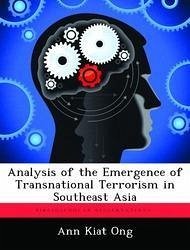Nicht lieferbar

Covering the Seams: Unifying Effort to Defeat Transnational Terrorism
Versandkostenfrei!
Nicht lieferbar
The Nation has formulated a strategy for combating terrorism that places the U.S. Military in a significant role. Perhaps the most significant role for the military in this effort will be globally operationalizing the application of military power to achieve the strategic objective to defeat transnational terrorism. The challenge for the United States'; application of military power lies in leveraging a regionally based operational command and control structure against a globally distributed threat. This monograph proposes that the existing organization, delineated responsibilities, and commen...
The Nation has formulated a strategy for combating terrorism that places the U.S. Military in a significant role. Perhaps the most significant role for the military in this effort will be globally operationalizing the application of military power to achieve the strategic objective to defeat transnational terrorism. The challenge for the United States'; application of military power lies in leveraging a regionally based operational command and control structure against a globally distributed threat. This monograph proposes that the existing organization, delineated responsibilities, and commensurate procedures of the operational military system of the United States, must adapt to meet the necessities of the world environment and defeat the threat of transnational terrorism. To better understand the operational challenges confronted in the Global War on Terror, a commensurate level analysis of the adversaries is necessary. The operational analysis uses the doctrinal elements of operational design to guide the examination of the adversaries. Furthermore, the analysis uses the third element of operational design as a measure of effectiveness for the command and control structure of the operational military in addressing the global threat of transnational terrorism. The analysis in this monograph proposes an operational center of gravity for both transnational terrorism and the United States. The analysis then examines the strategic aims, end states, and critical factors of the competing systems. From this operational analysis, the critical requirement for sanctuary is identified as an operational vulnerability for transnational terrorism. A similar analysis is conducted for the United States and identifies a vulnerability in unity of effort created by the regional focus of the command and control framework for the operational military. Based on the analysis, this monograph recommends the designation or creation of a single command and control entity with a global resp This work has been selected by scholars as being culturally important, and is part of the knowledge base of civilization as we know it. This work was reproduced from the original artifact, and remains as true to the original work as possible. Therefore, you will see the original copyright references, library stamps (as most of these works have been housed in our most important libraries around the world), and other notations in the work. This work is in the public domain in the United States of America, and possibly other nations. Within the United States, you may freely copy and distribute this work, as no entity (individual or corporate) has a copyright on the body of the work. As a reproduction of a historical artifact, this work may contain missing or blurred pages, poor pictures, errant marks, etc. Scholars believe, and we concur, that this work is important enough to be preserved, reproduced, and made generally available to the public. We appreciate your support of the preservation process, and thank you for being an important part of keeping this knowledge alive and relevant.








